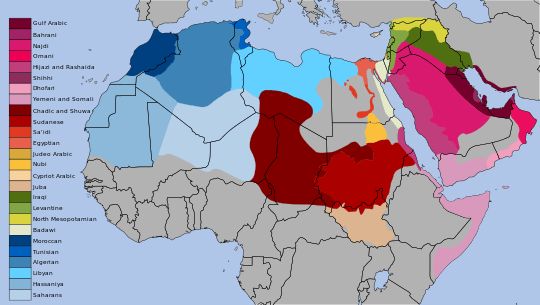Mashriqi Arabic
| Mashriqi | |
|---|---|
| ʿAmmiya | |
| Geographic distribution: | Mashriq |
| Linguistic classification: |
|
| Glottolog: | nort3191[1] |
Mashriqi Arabic, or ʿAmmiya, is the varieties of Arabic spoken in the Mashriq, including the countries of Egypt, Sudan, Yemen, Saudi Arabia, Lebanon, Palestine, Israel, Kuwait, Oman, the United Arab Emirates, Jordan, Syria and Iraq.[2][3][4][5] The Eastern Arabic known also as Mashriqi Arabic (as opposed to the Western Arabic known as Maghrebi Arabic) that includes Mesopotamian Arabic and Peninsular Arabic along with Levantine Arabic. In Lebanon, Mashriqi Arabic as a colloquial language was taught as a separate subject under French colonization, and some textbooks exist. Speakers of Mashriqi call their language ʿAmmiya, which means "dialect" in Modern Standard Arabic. It is primarily used as a spoken language; written communication is primarily done in Modern Standard Arabic (or English or French), along with news broadcasting. Mashriqi Arabic is used for almost all spoken communication, as well as in TV dramas and on advertising boards in Egypt and Lebanon whilst Modern Standard Arabic (الفصحى (al-)fuṣ-ḥā) is used for written communication. The varieties of Darija have a significant degree of mutual intelligibility, specially between geographically adjacent ones (e.g. Lebanese and Syrian, or Iraqi and Kuwaiti). Conversely, Darija is very hard to understand for Arabic speakers from the Maghreb, as it does derive from different substratums and a mixture of a few languages.
Mashriqi Arabic (known as Eastern Arabic) is the varieties of Arabic that are widely spoken in countries west of Iran and east of Saudi Arabia, such as Iraq and Kuwait and is somewhat different from classical Arabic (Saudi Arabia) Central or Egyptian Arabic and Western Arabic (Morocco, Algeria and Tunisia).[6]
Eastern Arabic includes Levantine Arabic, Mesopotamian Arabic, and Gulf Arabic (peninsular Arabic).
Varieties

References
- ↑ Hammarström, Harald; Forkel, Robert; Haspelmath, Martin; Bank, Sebastian, eds. (2016). "Western Asian Arabic". Glottolog 2.7. Jena: Max Planck Institute for the Science of Human History.
- ↑ "Mashriq". Britannica. Retrieved 5 July 2015.
- ↑ "European Neighbourhood Policy in the Mashreq Countries: Enhancing Prospects for Reform". Retrieved 15 April 2015.
- ↑ Introduction to Migration and the Mashreq
- ↑ Migrants from the Maghreb and Mashreq Countries
- ↑ http://easternarabic.com/
Further reading
- Singer, Hans-Rudolf (1980) “Das Westarabische oder Maghribinische” in Wolfdietrich Fischer and Otto Jastrow (eds.) Handbuch der arabischen Dialekte. Otto Harrassowitz: Wiesbaden. 249-76.